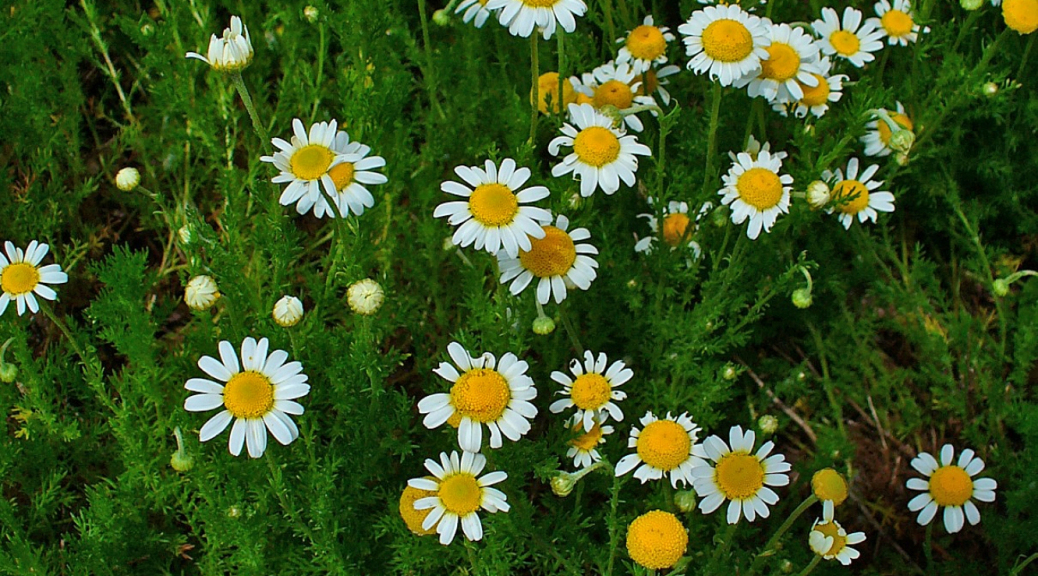We’ve made it to the new year, and by now have had cold weather for a while far too long. I don’t know about you, but we’re ready for winter to be over, and are busy daydreaming about all the plants slowly starting to come to life in the Spring. To keep out focus on the warmth to come, we’re going to talk about an essential oil that while it’s distilled from a flower, smells rather fruity and herb like.
The oil I’m referring to is Chamomile essential oil, or more specifically Roman Chamomile (Anthemis nobilis or Chamaemelum nobile).
Roman Chamomile is originally from Northern Ireland and Northwestern Europe, where it grows rather close to the ground much like a creeping plant. While it usually sticks close to the ground, it can grow up to one foot in height. The leaves are green-grey in color and the flowers have a bright yellow center, surrounded by stark white petals – not unlike a small daisy. Compared to German Chamomile, the plant sticks closer to the ground and the leaves are quite a bit thicker.
A lot of people can get confused between the two types of Chamomile because both look rather similar, both are used medicinally, and not to mention it’s usually a blend of both that you’ll find in a cup of Chamomile tea. Perhaps it doesn’t help that the term ‘Chamomile’ is used to describe both. However, the main difference is noted in the flower – the very part that is distilled to make the essential oil. As far as physical appearances go, the middle of the flower from the Roman Chamomile is solid, while in the German chamomile the center is hollow. But they also bear quite a different chemical make up, and because of that, the two actually belong to different Genera despite their physical similarities.
In history, the Greeks, Romans and Egyptians all used Chamomile. The Egyptians compared the daisy-like flowers to the sun and dedicated it to their sun god. The Romans used to bathe in it, and use it medicinally. The Greeks are the ones who gave it the name from which we have derived Chamomile. They called it ‘Kamaimelon’, ‘Kamai’ meaning ‘on the ground’ and ‘melon’ meaning apple.
Roman Chamomile essential oil is perhaps one of the most versatile oils that’s used in Aromatherapy today. From it’s anti-inflammatory benefits to it’s incredible calming effect on both the body and the mind. A lot of people can benefit greatly from a little Roman Chamomile. But let’s not forget to mention what it can do for the digestive system! Helping to relieve gastritis, bloating, IBS, nausea and indigestion just to name a few! Honestly, if you suffer from any kind of digestive upset, Roman Chamomile is certainly an oil to try!
Precautions: Roman Chamomile belongs to the ragweed family – avoid if you’re allergic. Beyond that, there are no known contraindications.
If I haven’t convinced you of the wonders of this essential oil. Perhaps knowing how soothing it can be to the skin as well will do the trick. Whether you’re dealing with dry, irritated skin, acne, eczema, facial puffiness or burns/sunburns, Roman Chamomile is sure to soothe your skin. But let’s not forget it’s most wonderful use. When diffused, it is the perfect oil to quiet rowdy and noisy children, irritated spouses or even yourself- all without inducing a catatonic effect.
*Please note that all essential oils are extremely potent and need to be respected. Always make sure you dilute the oils you use. You also don’t need a lot of the oil to reap it’s benefits and it’s always wise to err on the side of caution, especially when using oils on or around small children, elderly or people with underlying health conditions. When in doubt, always consult a Certified Aromatherapist before use.*

Magnificently, one of the best essential oils, it can be used as a basis for many blends
I completely agree, and such a lovely aroma too!